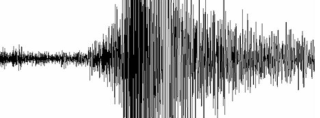|
This calibration step involves the adjustment of receiver amplifier gain with respect to the maximum MR signal occurring during imaging. If the attenuator value is set too low (i.e., receiver gain is set too high), then the signal will overload the analog-to-digital converter, and data clipping will occur. Since the largest peaks of the MR signal typically are the low order phase-encode steps at the center of k-space, data clipping interferes with image contrast. The result is an image with an "eerie" appearance as show right.
If the receive attenuator is set too high, then receiver gain will be insufficient, and image noise will increase. The scanner automatically calibrates receive attenuation by running a mock pulse sequence identical to that specified for imaging, except that the phase-encode gradient is set to zero (When the phase-encode gradient is zero, signal is maximal). After the receive attenuation is set, real scanning can begin. |
Advanced Discussion (show/hide)»
No supplementary material yet. Check back soon.
References
Aguilandam KV, Rao Am. Gain adjustment method and magnetic resonance imaging apparatus. US Patent #7,068,032 B2 dated 27 June 2006.
Shimazaki T, Watanabe Y, Iwaoka H. Automatic gain control apparatus for NMR imaging system. US Patent #4,700,138, dated 13 Oct 1987.
Aguilandam KV, Rao Am. Gain adjustment method and magnetic resonance imaging apparatus. US Patent #7,068,032 B2 dated 27 June 2006.
Shimazaki T, Watanabe Y, Iwaoka H. Automatic gain control apparatus for NMR imaging system. US Patent #4,700,138, dated 13 Oct 1987.
Related Questions
What is the scanner doing during the automatic pre-scan period?
What is the scanner doing during the automatic pre-scan period?


